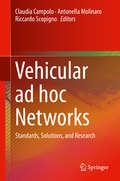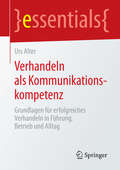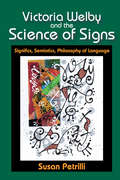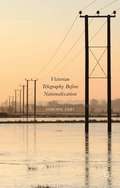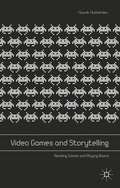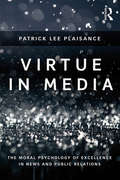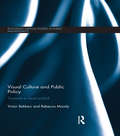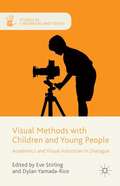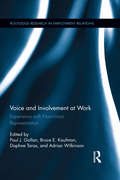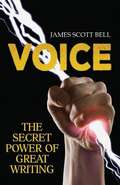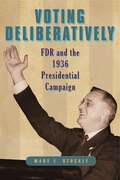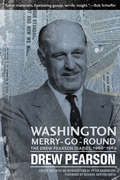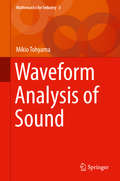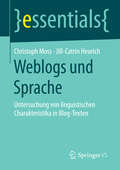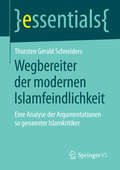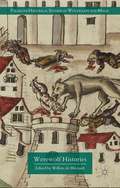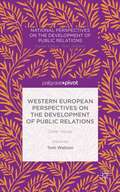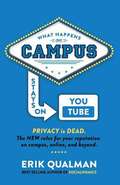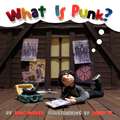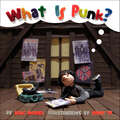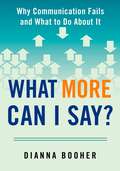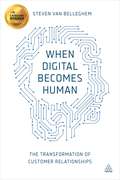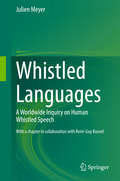- Table View
- List View
Vehicular ad hoc Networks
by Riccardo Scopigno Claudia Campolo Antonella MolinaroThis book presents vehicular ad-hoc networks (VANETs) from the their onset, gradually going into technical details, providing a clear understanding of both theoretical foundations and more practical investigation. The editors gathered top-ranking authors to provide comprehensiveness and timely content; the invited authors were carefully selected from a list of who's who in the respective field of interest: there are as many from Academia as from Standardization and Industry sectors from around the world. The covered topics are organized around five Parts starting from an historical overview of vehicular communications and standardization/harmonization activities (Part I), then progressing to the theoretical foundations of VANETs and a description of the day-one standard-compliant solutions (Part II), hence going into details of vehicular networking and security (Part III) and to the tools to study VANETs, from mobility and channel models, to network simulators and field trial methodologies (Part IV), and finally looking into the future of VANETs by investigating alternative, complementary communication technologies, innovative networking paradigms and visionary applications (Part V). The way the content is organized, with a differentiated level of technical details, makes the book a valuable reference for a large pool of target readers ranging from undergraduate, graduate and PhD students, to wireless scientists and engineers, to service providers and stakeholders in the automotive, ITS, ICT sectors.
Verhandeln als Kommunikationskompetenz: Grundlagen für erfolgreiches Verhandeln in Führung, Betrieb und Alltag (essentials)
by Urs AlterDr. Urs Alter gibt einen Überblick zu Kommunikationskompetenzen und macht mit vielen praktischen Hinweisen Mut, durch Verhandeln Lösungen bei unterschiedlichen Standpunkten zu suchen. Verhandlungen sind in der Beziehung zwischen Menschen alltäglich. Da sie jedoch immer konflikthaft sind und ein breites Repertoire an Kommunikationskompetenzen erfordern, vermeiden viele Menschen Verhandlungen. Dieses Essential zeigt, dass erfolgreiches Verhandeln gelernt werden kann und nicht Repräsentanten von Interessengruppen und hochrangigen Akteuren der Gesellschaft vorbehalten ist.
Victoria Welby and the Science of Signs: Significs, Semiotics, Philosophy of Language
by Susan PetrilliVictoria Welby (1837–1912) dedicated her research to the relationship between signs and values. She exchanged ideas with important exponents of the language and sign sciences, such as Charles S. Peirce and Charles S. Ogden. She examined themes she believed crucially important both in the use of signs and in reflection on signs. But Welby's research can also be understood in ideal dialogue with authors she could never have met in real life, such as Mikhail Bakhtin, Susanne Langer, and Genevieve Vaughan.Welby contends that signifying cannot be constrained to any one system, type of sign, language, field of discourse, or area of experience. On the contrary, it is ever more developed, enhanced, and rigorous, the more it develops across different fields, disciplines, and areas of experience. For example, to understand meaning, Welby evidences the advantage of translating it into another word even from the same language or resorting to metaphor to express what would otherwise be difficult to conceive.Welby aims for full awareness of the expressive potential of signifying resources. Her reflections make an important contribution to problems connected with communication, expression, interpretation, translation, and creativity.
Victorian Telegraphy Before Nationalization
by Simone FariVictorian Telegraphy Before Nationalization.
Video Games and Storytelling
by Souvik MukherjeeGrand Theft Auto IV saw more copies being sold than the latest superhero blockbusters or the last Harry Potter novel. Most of its players and critics commend its storytelling experience; however, when it comes to academic analysis, mainstream humanities research seems confused about what to do with such a phenomena. The problem is one of classification, in the first instance: 'is it a story, is it a game, or is it a machine?' Consequently, it also becomes a problem of methodology – which traditional discipline, if any, should lay claim to video game studies becoming the moot question. After weathering many controversies with regards to their cultural status, video games are now widely accepted as a new textual form that requires its own media-specific analysis. Despite the rapid rise in research and academic recognition, video game studies has seldom attempted to connect with older media and to locate itself within broader substantive discourses of the earlier and more established disciplines, especially those in the humanities. Video Games and Storytelling aims to readdress this gap and to bring video games to mainstream humanities research and teaching. In the process, it is also a rethinking story versus game debate as well as other key issues in game studies such as time, agency, involvement and textuality in video game-narratives.
Virtue in Media: The Moral Psychology of Excellence in News and Public Relations
by Patrick Lee PlaisanceThis work establishes a contemporary profile of virtue in professional media practice. Author Patrick Lee Plaisance examines the experiences, perspectives, moral stances, and demographic data of two dozen professional exemplars in journalism and public relations. Plaisance conducted extensive personal "life story" interviews and collected survey data to assess the exemplars’ personality traits, ethical ideologies, moral reasoning skills and perceived workplace climate. The chosen professionals span the geographic United States, and include Pulitzer Prize winners and trendsetting PR corporate executives, ranging from rising stars to established veterans. Their thoughts, opinions, and experiences provide readers with an insider’s perspective on the thought process of decision makers in media. The unique observations in this volume will be stimulating reading for practitioners, researchers, and students in journalism and public relations. Virtue in Media establishes a key benchmark, and sets an agenda for future research into the moral psychology of media professionals.
Visible Light Communication
by Shlomi ArnonVisible light communication (VLC) is an evolving communication technology for short-range applications. Exploiting recent advances in the development of high-power visible-light emitting LEDs, VLC offers an energy-efficient, clean alternative to RF technology, enabling the development of optical wireless communication systems that make use of existing lighting infrastructure. Drawing on the expertise of leading researchers from across the world, this concise book sets out the theoretical principles of VLC, and outlines key applications of this cutting-edge technology. Providing insight into modulation techniques, positioning and communication, synchronisation, and industry standards, as well as techniques for improving network performance, this is an invaluable resource for graduate students and researchers in the fields of visible light communication, optical wireless communication, and industrial practitioners in the field of telecommunications.
Visual Culture and Public Policy: Towards a visual polity? (Routledge Critical Studies in Public Management)
by Victor Bekkers Rebecca MoodyTraditionally, images have played an important role in politics and policy making, mostly in relation to propaganda and public communication. However, contemporary society is inundated with visual material due to the increasing ubiquity of media and visual technologies that facilitate the production, distribution and consumption of images in new and innovative ways. As such, a visual culture has emerged, and a number of authors have written on visual culture and the technologies which underlie it. However, a clear link to policy making is still lacking. This books links the emergence of this visual culture to policy making and explores how visual culture (and the growing number of technologies used to create and distribute images) influence the course, content and outcome of public policy making. It examines how visual culture and policy making in contemporary society are intertwined, elaborating concepts such as power, framing and storytelling. It then links this to technology, and the way this can enhance power, transparency, registration, surveillance and communication. Dealing with the entire cycle of public policy making, from agenda-setting, to policy design, decision making to evaluation, the book contains diverse international case studies including water management, risk management, live-stock diseases, minority integration, racism, freedom of speech, healthcare, disaster evaluation and terrorism.
Visual Methods with Children and Young People: Academics and Visual Industries in Dialogue (Studies in Childhood and Youth)
by Eve Stirling Dylan Yamada-RiceVisual Methods with Children and Young People.
Voice and Involvement at Work: Experience with Non-Union Representation (Routledge Research in Employment Relations #33)
by Adrian Wilkinson Paul J. Gollan Bruce E. Kaufman Daphne TarasIn the last decade, nonunion employee representation (NER) has become a much discussed topic in the fields of human resource management, employment relations, and employment/labor law. This book examines the purpose, structure, and performance of various types of employee representation bodies created by companies in non-union settings to promote collective forums for voice and involvement at the workplace. This unique volume presents the first longitudinal evidence on the performance, success, and failure of NER plans over an extended time period. Consisting of twelve detailed, in-depth case studies of actual NER plans in operation across four countries, this volume provides unparalleled evidence on such matters as: the motives behind the initial establishment of NER, different organizational forms of NER in industry, key success and failure factors over the long-term, pro and con evaluations for employers and employees, and more. Voice and Involvement at Work captures an unequalled international and comparative perspective through a wide cross-section of different NER forms.
Voice: The Secret Power of Great Writing
by James BellWhat is the single greatest secret to a breakout writing career? What is it that every agent and editor wants to see, and every reader delights in? It's VOICE. Everyone talks about it, yet no one seems able to define it. Voice has therefore been the most elusive aspect of the entire writing craft to teach. Until now. In this book, #1 bestselling writing teacher James Scott Bell reveals the true source of voice, and what any writer in any genre can do to capture it for their own work. In VOICE: The Secret Power of Great Writing you'll learn: * An actual working definition of voice that is simple yet powerful * Bell's original method for turning that definition into book-length voice power * How to vary voice from genre to genre, book to book * How to enhance voice with emotion, flow, and attitude * How to create vivid word pictures * Exercises to expand your voice and style * Example after example of voice in action Don't settle for good writing. Go for the unforgettable. The secret of voice will help you get there.
Voting Deliberatively: FDR and the 1936 Presidential Campaign (Rhetoric and Democratic Deliberation #12)
by Mary E. StuckeyThe 1932 election of Franklin Delano Roosevelt seemed to hold the promise of Democratic domination for years to come. However, leading up to the 1936 election, persistent economic problems, a controversial domestic agenda, and the perception of a weak foreign policy were chipping away at public support. The president faced unrelenting criticism from both the Left and the Right, and it seemed unlikely that he would cruise to the same clear victory he enjoyed in 1932. But 1936 was yet another landslide win for FDR, which makes it easy to forget just how contested the campaign was. In Voting Deliberatively, Mary Stuckey examines little-discussed components of FDR’s 1936 campaign that aided his victory. She reveals four elements of this reelection campaign that have not received adequate attention: the creation of public opinion, the attention paid to local organizations, the focus on specific kinds of interests, and the public rhetoric that tied it all together. Previous studies of the 1936 presidential election discuss elements such as FDR’s vulnerability before the campaign and the weakness of Republican candidate Alf Landon. But these histories pay little attention to the quantity and quality of information Roosevelt acquired, the importance of organizations such as the Good Neighbor League and the Committee of One, the mobilization of the vote, and the ways in which these organizational strategies fused with Roosevelt’s rhetorical strategies. Stuckey shows how these facets combined in one of the largest victories in Electoral College history and provided a template for future victory.
Washington Merry-Go-Round: The Drew Pearson Diaries, 1960-1969
by Richard Norton Smith Peter Hannaford Drew PearsonFor most of three decades, Drew Pearson was the most well-known journalist in the United States. In his daily newspaper column—the most widely syndicated in the nation—and on radio and television broadcasts, he chronicled the political and public policy news of the nation. At the same time, he worked his way into the inner circles of policy makers in the White House and Congress, lobbying for issues he believed would promote better government and world peace. Pearson, however, still found time to record his thoughts and observations in his personal diary. Published here for the first time, Washington Merry-Go-Round presents Pearson’s private impressions of life inside the Beltway from 1960 to 1969, revealing how he held the confidence of presidents—especially Lyndon B. Johnson—congressional leaders, media moguls, political insiders, and dozens of otherwise unknown sources of information. His direct interactions with the DC glitterati, including Bobby Kennedy and Douglas MacArthur, are featured throughout his diary, drawing the reader into the compelling political intrigues of 1960s Washington and providing the mysterious backstory on the famous and the notorious of the era.
Waveform Analysis of Sound
by Mikio TohyamaWhat is this sound? What does that sound indicate? These are two questions frequently heard in daily conversation. Sound results from the vibrations of elastic media and in daily life provides informative signals of events happening in the surrounding environment. In interpreting auditory sensations, the human ear seems particularly good at extracting the signal signatures from sound waves. Although exploring auditory processing schemes may be beyond our capabilities, source signature analysis is a very attractive area in which signal-processing schemes can be developed using mathematical expressions. This book is inspired by such processing schemes and is oriented to signature analysis of waveforms. Most of the examples in the book are taken from data of sound and vibrations; however, the methods and theories are mostly formulated using mathematical expressions rather than by acoustical interpretation. This book might therefore be attractive and informative for scientists, engineers, researchers, and graduate students who are interested in the mathematical representation of signals and the applications of Fourier analysis. The book can be described as being practically self-contained but does assume readers are familiar with introductory topics in discrete signal processing, as in the discrete Fourier transform. Hence this book might be also usable as a textbook in graduate courses in applied mathematics on topics such as complex functions. Almost all scientific phenomena are sensed as waves propagating in some space. Over the years, waveform analysis has therefore been one of the resilient academic areas of study and still is seen as fertile ground for development. In particular, waveform analysis based on the theory of linear systems would be a good example where a physical interpretation can be given to the mathematical theory of complex functions in terms of magnitude, angle, poles, and zeros of complex functions. For readers who are interested in the physical aspects of sound and vibration data or elementary formulation of wave equations and their solutions, the book Sound and Signals by M. Tohyama (Springer 2011) is recommended. It can serve as a complementary companion to this present volume or independently as a good reference.
Webinar Master
by Donald H. TaylorA step-by-step guide to delivering compelling online presentations from a webinar expert and coach.We’ve all attended dry, forgettable webinars, but few people know the secrets of truly engaging audiences online.In Webinar Master, Donald H. Taylor shares his methodology for delivering great webinars, consistently, distilled from his experience coaching hundreds of speakers since 2007.Taylor dissects the traps awaiting inexperienced presenters, and explains why people can’t stop themselves reading, why nobody can listen well online, and why you should use images and animations carefully. He examines the impact of audience sizes, when and how to work with facilitators and hosts, and gives tips for improving your delivery, from reading poetry aloud to playing Just a Minute.Packed with tips, checklists, technical advice, and myriad other resources, Webinar Master is a one-stop guide to producing compelling, well-structured content that keeps audiences engaged. From understanding the technology, to using your voice, to building rapport, this easy-to-read guide will teach you everything you need to know to run popular, interactive and useful webinars that will have your audience coming back for more.
Weblogs und Sprache: Untersuchung von linguistischen Charakteristika in Blog-Texten (essentials)
by Christoph Moss Jill-Catrin HeurichChristoph Moss und Jill-Catrin Heurich betrachten das Phänomen, dass die Verfasser von Blogs eine eigene Sprache mit spezifischen Darstellungsformen entwickeln, in einer empirischen Untersuchung. Dazu werden Weblog-Texte, journalistische Kommentare in Onlinemedien sowie Corporate Blogs auf ihre sprachlichen Charakteristika untersucht. Weblogs haben ihren Platz im Kommunikationskanon gefunden. Sie sind aufgrund ihrer einfach strukturierten Programmierweise von Suchmaschinen leicht zu erfassen. Das macht sie inhaltlich sowie kommerziell attraktiv.
Wegbereiter der modernen Islamfeindlichkeit: Eine Analyse der Argumentationen so genannter Islamkritiker (essentials)
by Thorsten Gerald SchneidersVorgetäuschte Islamkritik, die nur so tut, als verfolge sie seriöse Absichten, ist einer der Hauptverbreitungswege für Islamfeindlichkeit und Vorbehalte gegenüber Muslimen. Im deutschsprachigen Raum hat sich vor einigen Jahren ein Zirkel von Personen gebildet, der diese Art der ,,Islamkritik" öffentlichkeitswirksam vertrat. Dazu gehörten Mina Ahadi, Henryk Broder, Ralph Giordano, Necla Kelek, Alice Schwarzer, Udo Ulfkotte und Leon de Winter. Ihre Argumentationsweisen werden in diesem Essential mittels diskursanalytischer Ansätze untersucht. Der Autor stellt typische Techniken vor und leistet dadurch einen Beitrag, um echte Islamkritik künftig besser von Islamfeindlichkeit abgrenzen zu können.
Werewolf Histories (Palgrave Historical Studies in Witchcraft and Magic)
by Willem De BlécourtWerewolf Histories is the first academic book in English to address European werewolf history and folklore from antiquity to the twentieth century. It covers the most important werewolf territories, ranging from Scandinavia to Germany, France and Italy, and from Croatia to Estonia.
Western European Perspectives on the Development of Public Relations: Other Voices
by Tom WatsonThe National Perspectives on the Development of Public Relations: Other Voices series is the first to offer an authentic world-wide view of the history of public relations. It will feature six books, five of which will cover continental and regional groups. This book in the series focuses on Western Europe.
What Happens on Campus Stays on YouTube: Privacy Is Dead. The New Rules For Your Reputation On Campus, Online And Beyond
by Erik QualmanWhether we like it, love it, use it or hate it, escaping social media on any college campus is nearly impossible. When you arrive on campus, you will notice that social media isn't just a way to connect with friends but also a vast communication and marketing network for student organizations, internship opportunities and more! The purpose of this book is to not to tell you to avoid social media, but to help you start thinking about your digital reputation and providing you with some expert advice on using social media in a smart way. Even if you don't want to dive in right now, keep this book on your shelf for your future reference.
What Is Punk?
by Eric MorseOne of The Globe and Mail's Best Books of 2015"A punk primer for the youngest set....Yi's incredibly detailed clay figures are a kinetic and inspired art choice. Their crazy creativity matches the expressive spirit of punk....As [Morse] points out, the best way to learn about punk it just to listen....If invested adults love the topic, a shared reading experience can't be beat."--Kirkus Reviews"Clay artist Yi molds...fantastically detailed Plasticine figures to create scenes of the birth of punk. Using a benign craft-project material for the skinny bodies and ragged clothing of Joey Ramone, Sid Vicious, and their rowdy, fist-waving audiences is very much in the spirit of punk (Plasticine is especially good for mohawks), and readers will spend long stretches inspecting her painstakingly modeled guitars, amplifiers, and safety pins."--Publishers Weekly"Why It's Wild: A history of punk music for kids illustrated in Gumby-esque claymation (minus the -mation)."--School Library Journal, 100 Scope Notes's "Wildest Children's Books of 2015""What is Punk? is fun, sophisticated and beautifully illustrated introduction to the music genre for kids--or adults."--New York Daily News"Reading What is Punk? to [my kids] made me feel as if I was passing on something truly significant. Morse and Yi have created a comprehensive and articulate...documentary about the roots of punk rock."--The Globe and Mail"An essential way to pass down to your son or daughter the lesson that pop culture can be political."--The Globe and Mail, 100 Best Books of 2015"A cool book of punk history for kids by Eric Morse, with great clay illustrations by Anny Yi."--Slate, Mom and Dad Are Fighting podcast"Eric Morse's book What Is Punk? explains the envelope-pushing genre to the younger set, and perhaps some adults, as well."--St. Louis Public Radio"Think Wallace and Grommet with liberty spikes and anarchy patches...While [Anny Yi's] images of Johnny Rotten and Henry Rollins are cute, they're presented as live action dioramas that are adorable, accurate and engaging."--San Diego City Beat"While What Is Punk? is undeniably a children’s book, it can serve as a history lesson for potential fans of any age....What Is Punk? exposes the reader to the rebellious sub-culture in a friendly, educative manner."--Alternative Press"A fun little book intended to serve as (rhyming) curriculum for little punks learning their Punk History 101....Sid, Glenn, and Milo meet Wallace and Gromit."--Razorcake"Pairing Yi's Wallace & Gromit-style clay pictorials with Morse's rhyming ride through the history of punk music across the globe, the children’s book is ready to raise the next generation of riot grrrls....You're going to want to give What Is Punk? as a gift at every baby shower this year. Just don't be surprised if your niece ends up bleaching her hair blonde and tearing up her leather jacket at age 6."--Bustle"Written by Trampoline House founder Eric Morse in classically Suessical iambic, the book is lusciously illustrated with photographs of Play-Doh recreations of all mommy's and daddy's favorite punk heroes: the Ramones, Iggy and the Stooges--and Debbie Harry, David Byrne, David Johansen, Tom Verlaine, and Lou Reed all standing in front of CBGBs."--Bedford & BoweryWhat Is Punk? is a must-read pop-culture primer for children--an introduction to the punk revolution, recreated in vivid 3-D clay illustrations and told through rhyming couplets.From London's Clash and Sex Pistols to the Ramones' NYC protopunk, from Iggy Pop to the Misfits, this volume depicts some of our culture's seminal moments and iconic characters. A delightful read for kids and parents alike, illustrated in a truly unique visual style, What Is Punk? lays the groundwork
What Is Punk?
by Eric MorseA wonderfully illustrated children's history of punk rock, from a progressive/idealistic perspective.—One of The Globe and Mail‘s Best Books of 2015 “A punk primer for the youngest set. . . . Yi’s incredibly detailed clay figures are a kinetic and inspired art choice. Their crazy creativity matches the expressive spirit of punk. . . . As [Morse] points out, the best way to learn about punk it just to listen. . . . If invested adults love the topic, a shared reading experience can’t be beat.” —Kirkus Reviews “Clay artist Yi molds . . . fantastically detailed Plasticine figures to create scenes of the birth of punk. Using a benign craft-project material for the skinny bodies and ragged clothing of Joey Ramone, Sid Vicious, and their rowdy, fist-waving audiences is very much in the spirit of punk (Plasticine is especially good for mohawks), and readers will spend long stretches inspecting her painstakingly modeled guitars, amplifiers, and safety pins.” —Publishers WeeklyWhat Is Punk? is a must-read pop-culture primer for children—an introduction to the punk revolution, recreated in vivid 3-D clay illustrations and told through rhyming couplets. From London’s Clash and Sex Pistols to the Ramones’ NYC protopunk, from Iggy Pop to the Misfits, this volume depicts some of our culture’s seminal moments and iconic characters. A delightful read for kids and parents alike, illustrated in a truly unique visual style, What Is Punk? lays the groundwork for the next generation of little punks.Part of Akashic’s Black Sheep YA imprint.
What More Can I Say?
by Dianna BooherAn essential guidebook for honing business communication skills... Communications expert Dianna Booher provides an essential nine-point checklist for success in the art of communication and persuasion--for building solid relationships, and for increasing credibility in the workplace. With lessons from politics, pop culture, business, family life, and current events, the book identifies common reasons that communicators fail to accomplish their goals, along with examples and analyses of messages that succeed and those that fail.
When Digital Becomes Human
by Steven Van BelleghemIn an age when customers have access to vast amounts of data about a company, its product and its competitors, customer experience becomes increasingly important as a sustainable source of competitive advantage. But success doesn't just rely on digital engagement and excellence, but also on combining a digital-first attitude with a human touch. In When Digital Becomes Human, Steven Van Belleghem explores and explains the new digital relationships. Packed with global examples from organizations that have successfully transformed their customer relationships, such as Amazon, Toyota, ING, Coolblue, Nike and Starbucks, When Digital Becomes Human presents a clear model that companies can easily implement to integrate an emotional layer into their digital strategy. This guide to combining two of a business's most important assets - its people and its digital strengths - covers the latest issues in digital marketing and customer experience management, including omnichannel and multichannel experiences, big data and predictive analytics, privacy concerns, customer collaboration (ie crowdsourcing) and more.
Whistled Languages
by Julien MeyerThe main focus of this monograph on whistled speech is the result of a worldwide inquiry primarily based on the author's unprecedented fieldwork and laboratory experience. The different questions raised by the origin and the evolution of whistled forms of languages are also explored, including the role of environmental constraints in the emergence of whistled speech, their phonetic and phonological typology, the cognitive processing of whistled signals, monogenesis and polygenesis scenarios, the hypothesis of a whistled system preceding voiced speech, the intricate relationship between music and language in whistling, and the convergence/divergence with whistled communication among animals (birds, dolphins and primates). This book also includes several documents and a chapter prepared in collaboration with René-Guy Busnel, a pioneer in the studies of whistled forms of languages who has worked with five different populations using whistled speech (from the late 60s to the early 90s). The author has been intensively studying this fascinating language practice for the past 12 years, including 30 months of onsite research in collaboration with the cultural representatives of approximately twenty linguistic communities around the world. Whistled speech represents an ancient traditional telecommunication system that has survived on all inhabited continents of our planet. In it, a whistle replaces the voice and carries the information. However, this practice does not replace ordinary speech but is used in a complementary way. It serves to increase the audible range, but also under certain circumstances, the degree of secrecy of spoken communications. Whistled speech is adapted to the structure of each language, to specific traditional rural activities such as hunting or shepherding, and to specific ecological milieux. It is today a severely endangered speech register that provides an alternative insight into the nature of human language.
